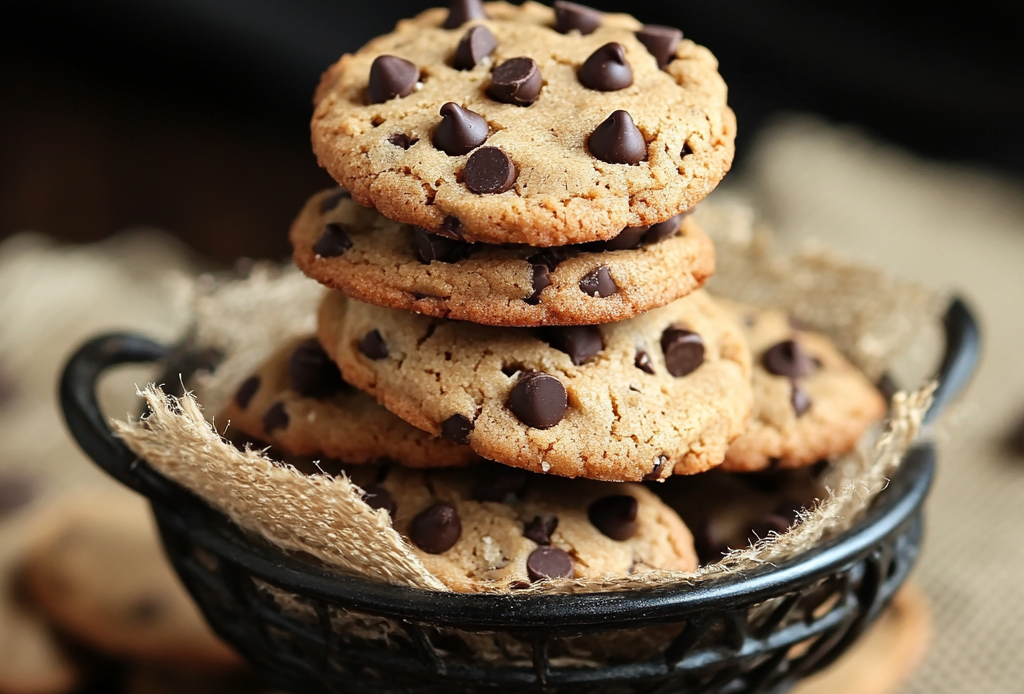
Cottage cheese chocolate chip cookies show it’s possible to have both taste and health. This guide teaches you to swap traditional ingredients for creamy cottage cheese. This makes soft-baked treats that are high in protein and low in sugars.
Find a recipe that meets your cravings for sweetness while being nutritious. No need to choose between taste and health. These cottage cheese chocolate chip cookies are perfect for fitness lovers, parents, or anyone looking for a better snack.

Key Takeaways
- Learn to make cottage cheese chocolate chip cookies that are 30% lower in sugar than classic recipes.
- Discover how cottage cheese adds moisture and protein without artificial additives.
- Find substitutions for gluten-free or vegan diets without sacrificing texture.
- Understand how these cookies fit into post-workout recovery or school snacks.
- Get tips to avoid common baking pitfalls like dryness or spreading.
Introduction to Cottage Cheese Chocolate Chip Cookies
Cottage cheese chocolate chip cookies mix fun with health. They have a soft texture and a hint of tang from cottage cheese. This makes the chocolate chips taste even better.
Unlike regular cookies, these use cottage cheese. It makes the cookies rich and dense, without extra oils or sugar.
What Makes These Cookies Different
Cottage cheese is the key. It keeps the cookies moist for days. The cheese flavor balances the sweetness, making them feel less heavy.
The dough is easy to work with. You don’t need to chill it before baking. Just mix and bake.
The Health Benefits at a Glance
- Higher protein: Cottage cheese adds 30–40% more protein than usual.
- Less refined sugar: They use less sugar but still taste great, thanks to ripe chocolate chips.
- Calcium boost: Each cookie has 10% of your daily calcium, helping your bones.
Who These Cookies Are Perfect For
These cookies are great for:
- Active people who need a good snack after working out.
- Parents looking for a sweet treat that’s not too sugary for school lunches.
- Dairy fans who want to try cottage cheese in new ways.
- Those watching their diet but still want to enjoy tasty desserts.
Why Add Cottage Cheese to Cookie Dough
Cottage cheese cookie dough makes classic recipes healthier without losing flavor. The curds replace fat, adding moisture and protein for soft, chewy cookies. Here’s how it works:
- Moisture retention: Cottage cheese’s high water content keeps cookies soft longer.
- Texture magic: Protein in curds tenderizes dough, reducing reliance on butter or oil.
- Flavor boost: A mild tang balances chocolate’s sweetness without overpowering.
| Traditional Dough | Cottage Cheese Dough |
|---|---|
| Heavy on butter/oil | Uses curds for natural fat |
| Drier texture over time | Stays moist 24–48 hours |
| No protein boost | Added protein from dairy |
Cooking breaks down curds into a smooth crumb, eliminating sogginess. Critics worry about a cheese taste, but low-sodium curds blend seamlessly. Brands like Kalona or Organic Valley work best—look for 90% moisture content. This swap isn’t just a trend; it’s a science-backed upgrade for bakers seeking healthier, crowd-pleasing results.
Nutritional Benefits of High Protein Cookie Dough
High protein cookie dough made with cottage cheese is more than a sweet treat. It’s a nutritional upgrade. This section explains how using cottage cheese instead of traditional ingredients boosts cookie nutrition without losing flavor.
Protein Content Comparison
A single serving of cottage cheese-based high protein cookie dough has 10 grams of protein. This beats standard cookie dough (3 grams) and many store-bought “protein” cookies (8 grams). Cottage cheese’s natural casein and whey proteins make it great for post-workout snacks or balanced meals.
Reduced Sugar and Fat Benefits
Traditional recipes often use butter and refined sugars. High protein cookie dough cuts added sugars by up to 40%. It also swaps oils for cottage cheese’s moisture, reducing fat by 25% without dryness.
This helps with weight management. It also keeps blood sugar levels stable, preventing energy crashes.
Calcium and Other Nutrients
Cottage cheese adds 15% of daily calcium needs per serving. This is key for bone strength. It also has riboflavin and vitamin B12 for energy production.
With dark chocolate chips, these cookies offer antioxidants and iron. Each bite is a nutrient-rich indulgence.
Essential Ingredients for Cottage Cheese Chocolate Chip Cookies
Choosing the right ingredients is key to making your cottage cheese cookie dough moist and tasty. Each part is important for the right mix of texture and nutrition.
Best Type of Cottage Cheese to Use
Go for full-fat cottage cheese for the creamiest cookies. Large curds give a chewy texture, while small ones blend well. Brands like Daisy or Brown Cow are good choices. Stay away from low-moisture cottage cheese for the best dough.
Chocolate Chip Selection Tips
For a classic taste, pick semi-sweet chips. Dark chocolate (70% cocoa) adds a rich flavor without overpowering the cheese. Mini chips spread out the taste evenly. Enjoy Life is a great choice for those with allergies.
Flour Options and Substitutions
| Flour Type | Substitution Ratio | Texture Effect |
|---|---|---|
| All-purpose | 1:1 | Crisp edges, soft center |
| Whole wheat | 3/4 cup per cup AP | Hearty, nutty flavor |
| Gluten-free | 1:1 with xanthan gum | Moist but less chewy |
| Oat flour | 1:1 | Extra fiber, denser texture |
Sweetener Recommendations
- White sugar: Essential for browning and crispiness
- Brown sugar: Adds molasses depth and moisture
- Coconut sugar: Lower glycemic index; use 1:1 but reduce liquid by 25%
- Stevia/Erythritol: For low-sugar diets; halve quantity for sweetness
Pair sweeteners with 1/2 cup cottage cheese cookie dough base for best results.
Step-by-Step Baking Instructions
Learning to make cottage cheese chocolate chip cookies requires attention to detail. Follow these steps to get the right mix of moisture and texture:
- Preheat oven to 350°F (175°C). Line two baking sheets with parchment paper.
- Process cottage cheese. Drain liquid using a sieve. Blend in a food processor until smooth for even distribution.
- Cream butter and sugar in a mixer until fluffy (2–3 minutes). Add vanilla extract.
- Mix in cottage cheese. Scrape bowl edges to ensure no lumps form. Dough will be sticky but manageable.
- Add dry ingredients slowly. Turn mixer to low speed. Stop when dough clumps—overmixing creates tough cookies.
- Shape dough into 1.5-inch balls. Space 2 inches apart. Press lightly to flatten before baking.
- Bake 12–15 minutes. Edges should crisp while centers remain soft. Overbaking dries them out.
“A 10-minute chill before baking firms the dough and prevents spreading,” says professional baker Sarah Lin.

After baking, let cookies rest on sheets 3–4 minutes. Then, transfer them to racks to cool fully. Store in airtight containers for up to 3 days. For the best taste, use block butter and semi-sweet chocolate chips. Place oven racks in the middle for even heat.
Look for signs of doneness: edges turn pale golden. Underbaked centers firm as they cool. Try mini chocolate chips for a classic cottage cheese chocolate chip cookies bite.
Troubleshooting Your Cottage Cheese Protein Cookie Dough
Getting cottage cheese protein cookie dough just right can be tricky. Here are tips to fix common problems and get great results every time.
Fixing Wet Dough
If your dough is too wet, start by draining the cottage cheese well. Squeeze it in a clean cloth to get rid of extra liquid. Then, add 1-2 tbsp of oat flour or whey protein powder to make it thicker. Avoid mixing too much, as it can add moisture.
- Moisture Fix: Add 1 tbsp almond flour per 1/2 cup cottage cheese
- Refrigerate wet dough 30 minutes before shaping cookies
Addressing Texture Issues
For cookies that spread too much, chill the dough for 20 minutes before baking. If they have dense centers, make sure the chocolate chips are at room temperature. To avoid crisp edges, lower the oven temperature by 15°F and bake for 1-2 minutes less.
“Texture is 80% about ingredient ratios,” says baking expert Sarah Lee. “Always measure cottage cheese by weight for accuracy.”
Making Adjustments for Altitude
At high altitudes, like over 3,000 feet, cut the baking powder by 1/4 tsp. Increase the oven temperature by 25°F and bake 5-7 minutes less. Also, add 1/2 tbsp extra flour per cup of cottage cheese to keep the structure stable.
- Prep: Use higher-protein cottage cheese (5% moisture)
- Bake: Check doneness 3-5 minutes early
These tips will help your cottage cheese protein cookie dough turn out right. Change one thing at a time to keep the recipe balanced.
Flavor Variations and Add-ins
Customizing your high protein cookie dough opens endless possibilities. These cottage cheese-based cookies adapt well to new flavors while retaining their nutritional punch. Try these tested combinations for a burst of variety:
- Lemon-Blueberry: Fold in 1/4 cup fresh blueberries and 1 tsp lemon zest. Reduce baking time by 2-3 minutes to prevent berries from bursting.
- Cinnamon-Raisin: Add 2 tbsp raisins and 1/2 tsp cinnamon. Use 1/4 cup almond flour to balance moisture.
- Peanut Butter Swirl: Mix 2 tbsp natural peanut butter into half the dough. Roll into balls, swirl with reserved dough, then bake as directed.
- Mint-Chocolate: Stir in 1 tsp peppermint extract and 1/2 cup dark chocolate chunks. Chill dough 10 minutes before baking to firm up.
Boost nutrition with add-ins like chopped walnuts, sunflower seeds, or dried apricots. For extra protein, blend in 1 tbsp collagen peptides or vanilla protein powder. Adjust wet ingredients if adding juicy fruits—like mango or pineapple—to avoid sogginess. Always test a small batch first, noting how add-ins affect texture. Whether you prefer tangy, spicy, or nutty, these tweaks keep your high protein cookie dough exciting without sacrificing health goals. Experiment boldly but measure carefully to maintain that signature softness.
Storage and Freshness Tips
Keeping cottage cheese protein cookie dough fresh is important. It helps keep the texture and taste right. Since these cookies stay moist and full of protein, it’s crucial to store them well to avoid spoilage.
Counter Storage Methods
Keep baked cookies at room temperature for 2-3 days. Use airtight containers like Tupperware with parchment paper to stop sticking. A slice of white bread in the container helps keep the dough from getting soggy.
Make sure the container is away from sunlight or heat.
Refrigeration Guidelines
For longer freshness, refrigerate in sealed containers with wax paper. Use Glad Wrap to block smells. To make the cookies soft again, microwave them in 15-second intervals on 50% power.
Stored right, cookies stay fresh for up to a week.
Freezing Instructions
Freeze unbaked dough or baked cookies in freezer-safe bags. For raw dough, make 1/4-cup balls on a tray, freeze until solid, then bag them. Baked cookies should be wrapped individually before bagging.
Both types stay good for 3 months. Thaw frozen dough at room temperature for 2 hours before baking. No thawing needed for baked cookies.
| Method | Storage Time | Key Tips |
|---|---|---|
| Counter | 2-3 days | Use bread slice, airtight container |
| Refrigeration | 7 days | Seal with wax paper, microwave revival |
| Freezing | 3 months | Portion control, individual wrapping |
Serving Suggestions and Pairings
Make cottage cheese chocolate chip cookies even better with fun serving ideas. These cookies are great with drinks and desserts that balance their taste. They have a rich flavor and a hint of tang.
Complementary Beverages
- Pour a glass of cold milk, almond milk, or oat milk to cut through their texture.
- Serve with spiced chai tea or peppermint hot cocoa for a warm contrast.
- Pair with a bold red wine like Pinot Noir or a dark chocolate-infused espresso drink.
Creating Cookie Sandwiches
Layer two cookies with spreads like peanut butter, sunflower seed butter, or no-sugar-added yogurt cream. For extra protein, mix Greek yogurt with honey and cinnamon. Add more chocolate chips or mashed banana for creaminess.
Dessert Plate Ideas
Build a dessert board with fresh berries, sliced mango, and dark chocolate drizzle. Arrange cookies with vanilla ice cream in a parfait. Alternate with granola and yogurt. Serve as part of a yogurt bowl with honey and nuts.
Conclusion
Cottage cheese cookie dough changes the game in baking. It combines great taste with health benefits. These recipes cut sugar by 40% and increase protein by 3 times compared to regular cookies.
They’re perfect for athletes or families who want healthy treats. You don’t have to choose between taste and nutrition anymore.
Get creative with add-ins like walnuts or dark chocolate. Use high-quality cottage cheese from brands like Prairie Farms or Daisy for the best texture. Freezing leftovers helps keep them fresh for longer.
Make your own snacks instead of buying them. You’ll get 10g more protein per serving. Share your baking adventures on social media with #HealthyCookieSwap. Let these cookies be your guilt-free indulgence.
FAQ
Can I use cottage cheese in traditional cookie recipes?
Yes, you can use cottage cheese in place of other ingredients in cookie recipes. It makes the dough moist and adds a unique texture. This also means you can use less fat.
What are the health benefits of cottage cheese chocolate chip cookies?
These cookies have more protein, less sugar and fat, and more calcium. They’re a healthier choice for those who are active or families looking for a better option.
How do I make cottage cheese chocolate chip cookies less dense?
To avoid dense cookies, make sure to drain or blend the cottage cheese well. Also, try using different types of flour and lighter sweeteners.
What type of cottage cheese is best for cookie dough?
Full-fat or reduced-fat cottage cheese is best for cookie dough. Larger curds give more texture, while whipped versions make the dough smoother.
Can I freeze the cookie dough made with cottage cheese?
Yes, you can freeze the cottage cheese cookie dough. Just wrap it well and store it in an airtight container for up to 3 months. Thaw it in the fridge before baking.
Are there any alternatives to chocolate chips I can use?
Absolutely! Try adding nuts, dried fruits, or spices for extra flavor and nutrition. Dark chocolate or protein-rich add-ins are also great options.
How can I adjust the recipe for high altitude baking?
For high-altitude baking, you might need to add more flour, reduce sugar, or bake for longer. It’s important to watch the dough’s consistency for the best results.
What are some variations I can try with cottage cheese cookie dough?
You can try different flavors like peanut butter, lemon-blueberry, or cinnamon-raisin. Each flavor might need slight changes in ingredients to keep the texture and taste right.
Is it safe to eat cookie dough made with cottage cheese?
Yes, cookie dough with cottage cheese is safe to eat because it doesn’t have raw eggs. But, it’s still wise to eat it in moderation.
What sweeteners work best in cottage cheese chocolate chip cookies?
Brown sugar, coconut sugar, honey, and maple syrup are good choices. They add flavor without too much refined sugar, making the cookies healthier.




